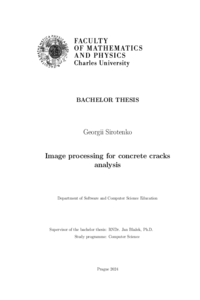Zpracování obrazu pro detekci trhlin v betonu
Image processing for concrete cracks analysis
bachelor thesis (DEFENDED)

View/
Permanent link
http://hdl.handle.net/20.500.11956/193206Identifiers
Study Information System: 265043
Collections
- Kvalifikační práce [11325]
Author
Advisor
Referee
Šikudová, Elena
Faculty / Institute
Faculty of Mathematics and Physics
Discipline
Computer Science with specialisation in Artificial Intelligence
Department
Department of Software and Computer Science Education
Date of defense
6. 9. 2024
Publisher
Univerzita Karlova, Matematicko-fyzikální fakultaLanguage
Czech
Grade
Very good
Keywords (Czech)
detekce trhlin|zpracování obrazu|analýza betonu|deep learningKeywords (English)
crack detection|image processing|concrete analysis|deep learningProblém detekce změn pomocí hlubokého učení je aktivní oblastí výzkumu v oboru počítačového vidění. Metody hlubokého učení dosahují v této oblasti výsledků, které překonávají tradiční přístupy. Tato práce se zaměřuje na bi-temporální detekci změn, při- čemž vstupními daty jsou videa betonových vzorků s vysokým rozlišením. Sledovanými defekty jsou trhliny, které vznikají během ozařování vzorku. Autor navrhuje postup pro detekci změn od zpracování videa až po konstrukci masky nových trhlin. V práci jsou analyzovány a porovnány různé přístupy a architektury založené na semi-supervised a supervised learningu. Práce se zabývá jak osvědčenými konvolučními neuronovými sítěmi (CNN), tak nejnovějšími přístupy, včetně aktuálně nejlepších metod využívajících Vision Transformer. Kromě analýzy stávajících řešení autor navrhuje vlastní architektury a op- timalizační techniky, které využívají evoluční algoritmy. Součástí práce jsou tři veřejně dostupné datasety.
The problem of change detection using deep learning approaches is an active area of study in the field of computer vision, demonstrating results that outperform traditional approaches. This thesis aims to solve the problem of bi-temporal change detection of high-resolution videos with a focus on defects in the form of cracks, where the videos are recorded concrete cylinders and the changes are caused by radiation. The work proposes a pipeline for solving this problem from video acquisition and processing to final predictions, while analyzing and comparing different approaches and architectures based on semi-supervised and supervised learning. The thesis considers both well-proven CNNs and the latest approaches in the form of current SOTA leveraging Vision Transformer. In addition to analyzing existing solutions, we also propose our own architectures and optimization techniques using evolutionary algorithms. Part of the work also includes the creation of three datasets and their publication.
